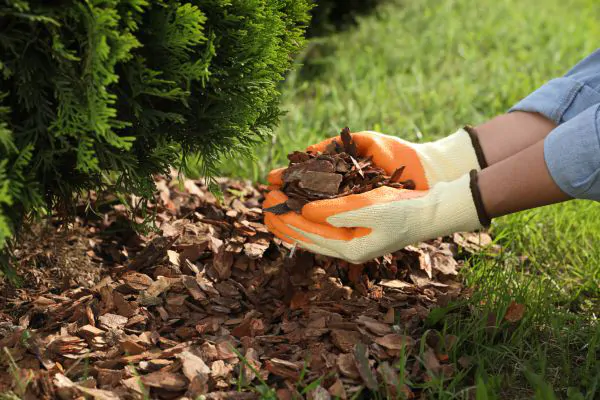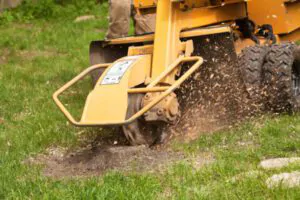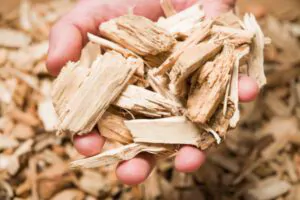In the aftermath of engaging professional tree care services, homeowners may find themselves with an abundance of wood chips from stump grinding and tree removal.
While these remnants might seem cumbersome at first, they hold a treasure trove of possibilities for creative and sustainable use around the property.
From garden enrichment to eco-friendly practices, these wood chips can be pivotal in achieving a more fruitful and responsible outdoor space.
Keep reading to discover a variety of ingenious methods to repurpose these wood byproducts into valuable assets for your home and garden.
Creative Uses for Wood Chips After Tree Removal

After the stump grinding service, the question of what to do with wood chips from grinding arises. Rather than being a mere byproduct, these wood chips hold a multitude of beneficial uses for garden or lawn care. Creative homeowners and gardening enthusiasts find that these organic materials can be transformed into mulch, which, when spread around plants, enriches soil health while also conserving moisture and reducing weed growth.
Landscape aesthetics can be enhanced significantly by integrating wood chips into garden walkways or as a decorative ground cover. Not only do these wood chips invite a natural, rustic charm, but they also encourage a healthier walking surface over muddy or eroded areas. The composting process of these chips adds nutrients back to the soil, thus fostering a more vibrant garden ecosystem.
Composting is another possible option for what to do with wood chips after tree removal. Stump grindings mixed with dirt and other organic waste can lead to the creation of a rich, naturally compost pile. This compost serves as a powerful supplement to garden beds, providing the required nourishment for the thriving plant growth of a wide array of species.
Sustainable Options for Repurposing Wood Chips
Sustainable gardening practices emphasize the reuse of organic materials, and wood chips from stump removal can play a pivotal role in this approach. Rather than discarding these materials, environmentally conscious individuals can use them to accentuate garden beds or integrate them into permaculture designs. By doing so, they not only uplift the appearance of their outdoor spaces but also endorse soil preservation and biodiversity.
In certain scenarios, homeowners may ponder the fate of the stump grindings from their yard, especially when faced with large quantities. Engaging with services or community groups who will pick up stump grindings provides a solution that supports local agricultural or horticultural projects. Such partnerships can turn the remnants of a removed tree into a resource for urban gardens, school projects, or public park developments, thus closing the loop on waste.
Wood chips obtained after tree removal can also offer a unique solution for soil erosion problems. Strategically placed, these chips reduce runoff and sedimentation on slopes and embankments, protecting the underlying soil structure. Their utility in this sense, showcases the chips’ versatility beyond their origin, allowing nature’s cycle to continue in a resourceful and sustainable manner.
Enhancing Garden Soil with Stump Grindings
Incorporating stump grindings into garden soil is an excellent method for enriching the earth’s nutrient profile. When mixed into the top layers of soil, these wood chips from stump grinding decompose slowly, releasing organic matter that improves soil structure and fertility over time.
Gardeners enjoy the sight of their plants flourishing, and utilizing stump grindings as a soil amendment can significantly contribute to this process. The added structure provided by the grindings promotes better root growth, permitting plants to anchor more securely and access water and nutrients more efficiently.
The practice of using stump grindings mixed with dirt also serves as a natural pest deterrent. As the wood chips break down, they create an environment less hospitable to common garden pests, reducing the need for chemical interventions and fostering a more organic approach to plant care.
You might like: Average Cost Of Stump Grinding
Composting Stump Grindings: A Gardener’s Guide
Embracing the ethos of resourcefulness within the realm of horticulture, gardeners are continually seeking innovative methods to repurpose organic waste. Composting, a time-honored practice, garners attention for its role in sustainable gardening—particularly when it involves stump grindings from tree removal operations.
This segment serves as a primer, exploring the subtleties of mulching techniques with wood chips, the aesthetic and practical enhancements they bring to landscaping areas, the array of entities interested in collecting stump grindings for various purposes, and the overarching positive environmental ramifications of wood chip reuse.
It beckons a deepened appreciation for the cyclical nature of organic materials, underscoring how the very byproducts of tree services can stimulate new life in gardens and landscapes.
Mulching Techniques with Wood Chips
Employing wood chips as mulch brings multiple layers of improvement to garden maintenance: it aids in moisture retention, suppresses weeds, and gradually nourishes the soil as it decomposes. When applying wood chips, gardeners should layer them around plants, leaving some space around the stem base to prevent rot.
Layering wood chips uniformly to a depth of two to four inches ensures effective weed suppression and moisture conservation. Distributing wood chips over the soil with existing autumn leaf litter can accelerate decomposition, simultaneously enriching the soil with necessary nutrients. Regular monitoring of the mulched area for signs of insect activity or oversaturation will help maintain the garden landscape’s health and aesthetics.
Related Post: MULCH VS. WOOD CHIPS
Landscaping Benefits
Landscaping draws its beauty not only from the arrangements of plants and stones but also from the condition of the soil itself. The application of composted stump grindings elevates the visual appeal and health of outdoor spaces, providing a backdrop that enhances the vibrancy of the plant colors and the overall lushness of the garden.

Composted wood chips enrich the soil, bolstering the growth of flowers and shrubs and creating a more robust and appealing lawn. The use of these natural, decomposed materials demonstrates an investment in sustainable practices, contributing to a garden’s green credentials. The improved soil structure resulting from composted stump grindings facilitates the introduction of diverse plant species, fostering an attractive and biodiverse environment.
Who Collects Stump Grindings: Disposal Options

Finding avenues for the collection of stump grindings after professional tree services is pivotal for those who have an abundance of this material and desire a sustainable disposal option. Local landscapers, community gardens, and mulch manufacturers often seek out such organic waste, recognizing its value for various horticultural and agricultural applications. Municipalities sometimes facilitate green waste programs, allowing residents to contribute to city composting initiatives.
They know what to do with wood chips from stump grinding and may offer a service to collect these shavings for reuse in their projects. This way, they can help with reducing waste and supporting local businesses. Community gardens are often delighted to receive stump grindings as they can use them to enhance soil quality and suppress weeds. Mulch manufacturers might pick up large quantities of shavings, repurposing them into commercial wood mulch products. City composting programs provide an ecological way to dispose of these wood pieces while contributing to community greening efforts.
Environmental Impact of Reusing Wood Chips
The environmental benefits of repurposing wood chips from stump grinding align with the principles of circular economy, reducing waste by transforming what would be discarded material into a valuable resource for soil enhancement and plant health. This practice lessens the burden on landfills, diminishes the carbon footprint associated with waste transport, and secures a productive life cycle for organic matter, thereby reinforcing the ecological health of the garden ecosystem and surrounding natural habitats.
Conclusion
What do you do with wood chips from stump grinding? In summary, the innovative use of wood chips from tree stumps plays a crucial role in sustainable gardening and lawn care management. By transforming these byproducts into mulch, incorporating them into compost piles, and using them to prevent soil erosion, gardeners and homeowners can enrich their soil, enhance the beauty and biodiversity of their outdoor spaces, and contribute to environmental health.

Additionally, wood chips offer a practical solution for pathways, add aesthetic value as ground cover, and serve as a natural deterrent to pests.
Reusing wood chips demonstrates a commitment to sustainability, promoting soil preservation, reducing waste, and supporting the circular economy. Consequently, it’s important to recognize the value of these organic materials and utilize them creatively and responsibly in our gardens and landscapes.
For more information about tree stump removal, contact South Shore Tree Service. Our company is ready to answer your questions!





